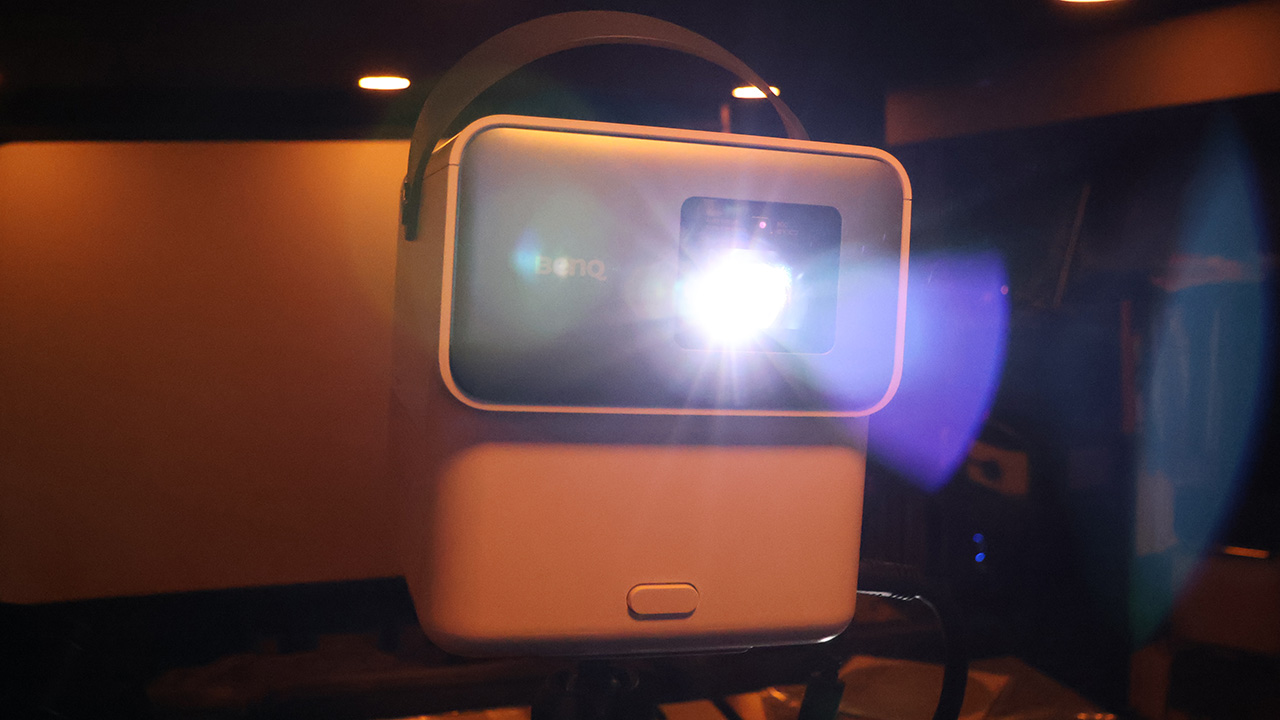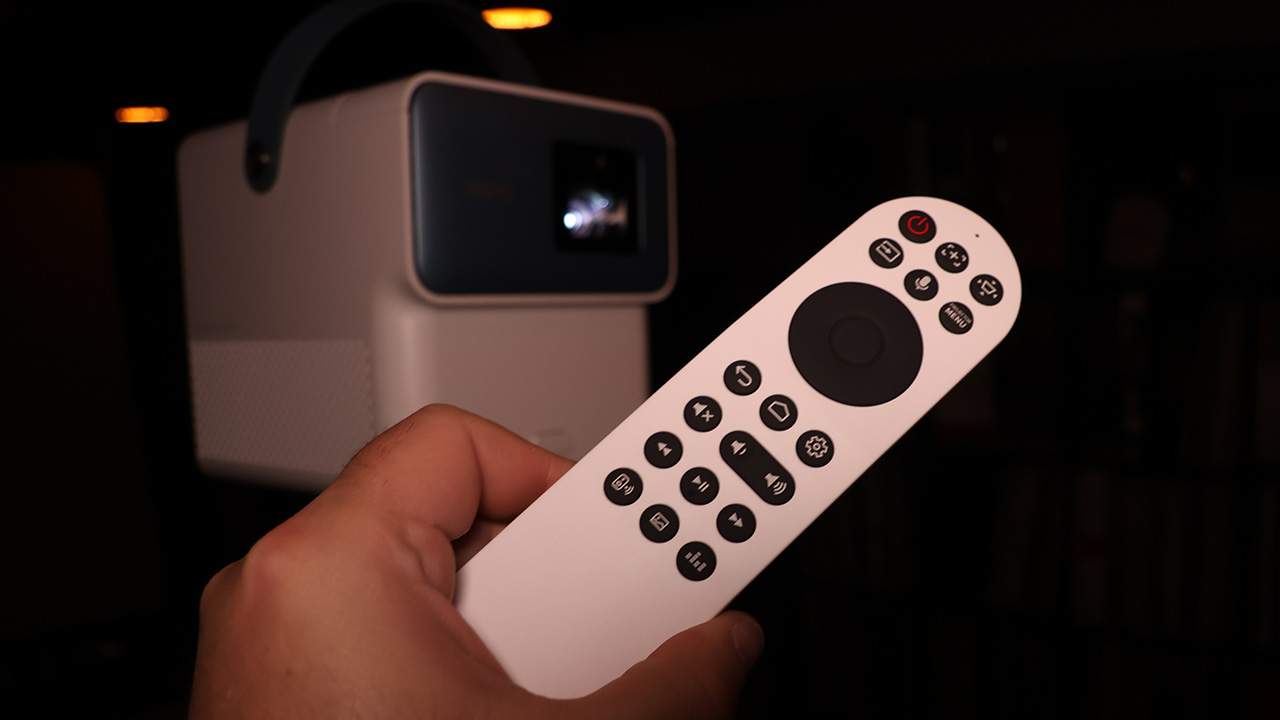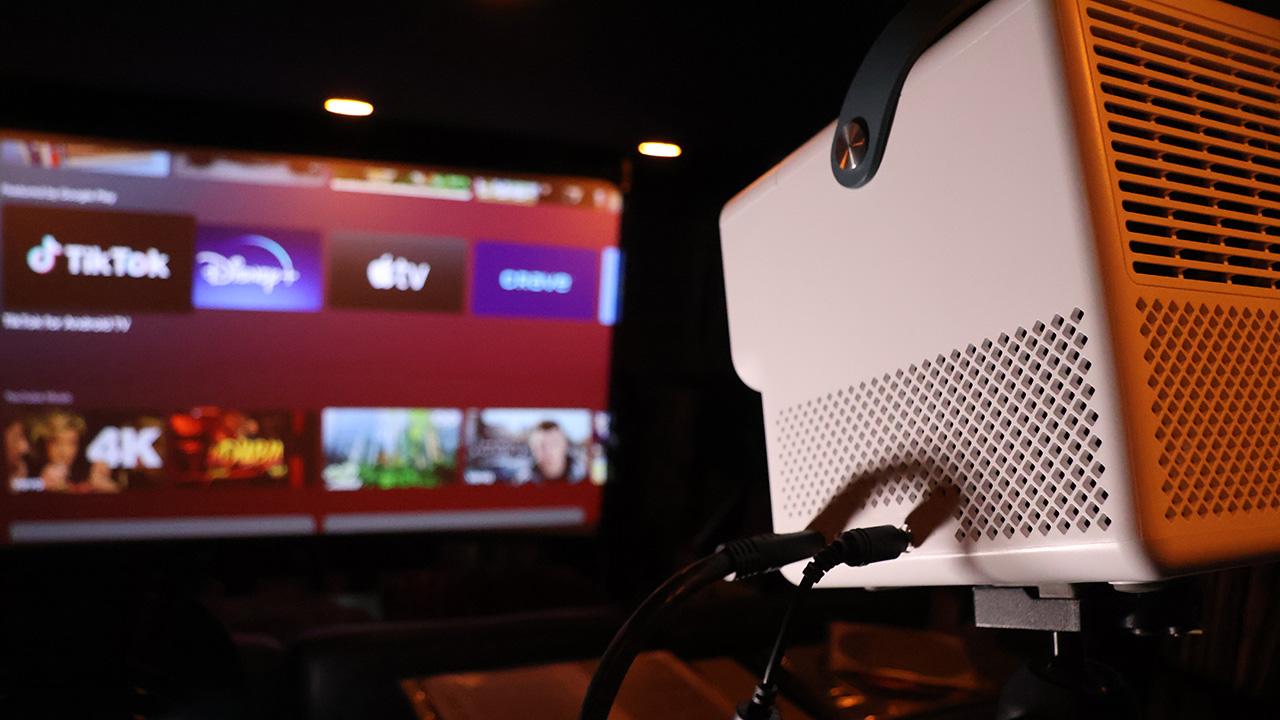
When reviewing any consumer electronics we tend to focus on things like performance, value, build quality and other such quotidian concerns. But what about adorability? Out of the box the GP100A projector from BenQ is, frankly, adorable—a cute little package that almost feels like a companion droid out of a science fiction tale, complete with a “face” with a single eye and a handle that allows you to plop it down wherever you’d like. Yet does its diminutive form factor prevent it from being a powerhouse projector?
BenQ GP100A projector specifications
- LED light source (20,000hrs / 30,000hrs on ECO mode)
- Native Resolution: 1920×1080
- Input Resolution: 4K UHD (3840×2160) to VGA (640×480)
- Contrast Ratio: 100,000:1
- 24-bit colour
- Throw ratio: 1.2 (fixed Zoom Ratio)
- Automatic keystone adjustment
- 2 HDMI inputs + 1 Internal input, 2 USB-A ports, 1 USB-C port
- 5W stereo speakers, 10W woofer, 3.5mm audio output, ARC 2 channel via HDMI
- QS02 Android dongle
- Carry bag, remote control included

Unboxing and setting up the BenQ GP100A Portable Projector
Inside a relatively sleek cardboard box, nestled between some styrofoam, is the GP100A. The carry handle makes it easy to slip out, while documentation, a remote with batteries, and the QS02 dongle are also contained within. A small Phillips screwdriver is included to undo the back two screws, allowing the top plate to slide backwards. Inside, there’s a micro-USB cable on the left side and an embedded HDMI male connector on the right, designed to perfectly accommodate the streaming stick. Once you connect the USB for power you slide the stick onto the HDMI port—while it’s a bit fiddly, once lined up horizontally it secures with a satisfying click. You then slide the top plate back, tighten the two screws, and you’re good to go.

With the addition of the stick you can, without doing much of anything else hardware wise, be up and running right away. Powering on the unit displays the BenQ logo, and then the picture is automatically both focused and keystone adjusted, thus making sure you’re getting a level and clear image on whatever clean surface you’re aimed at. Setting up the Android system was quickly accomplished, and, as an Android phone user, a familiar experience, with my credentials all carrying over from previous installs. For those new to the ecosystem you may need to create an account, but once this is done everything else is extremely straightforward.
The unit itself has speakers within, meaning that as soon as you have Wi-Fi configured and your apps up and running you are watching and listening to visual content without plugging in anything save for the power lead.
While there is no optical zoom adjustment, there is a digital zoom option that allows you to essentially shrink the area that’s being projected within the native scope of the lens. For a smaller size projection move the projector closer to the screen, for a larger one, further back.
Given the ability to automatically keystone and focus in seconds, it was quite fun plopping the projector down in a room with busy ways and watching the system somehow find a decent space to form a 16:9 rectangular image. On torture tests like this the results were of course mixed, but I was often amazed how, even when trying to get images on the ceiling, I was able to make the most of the situation.
Using 4K HDMI input
For those that wish to expand their setup, there’s an HDMI input on the side which supports ARC, meaning you can use the built-in apps but run an HDMI to your receiver to get stereo sound. There’s a 3.5mm audio jack for even easier audio augmentation, and you can configure external Bluetooth streaming to whatever device you wish. A note for those running HDMI—I got a quite considerable ground hum when plugging into my main system, something that’s often endemic when plugging in equipment at the back of the room when the rest of your setup is on different circuits. A change to a thickly shielded HDMI did nothing to ameliorate, but using a ground-lifting plug for testing purposes did to the trick. While this is of course never recommended for permanent install, given the portable nature of the projector it maybe the simplest solution for you. You can also go with optical HDMI cables or use the slightly bitrate-starved wireless options instead of a full bandwidth 4K HDMI signal.
BenQ GP100A image quality

In a fully light controlled home theatre the image results with the GP100A were surprisingly excellent. Sure, there are superior projection technologies from more premium models that deliver even better colour performance and a more wide dynamic range, but when the lights are off and the windows blocked I was charmed by what a good image I was able to achieve from such a small and conveniently designed package.
While its resolution is locked to a native 1080p, the HDMI input (and even its internal streaming services) were able to playback 4K files. The result, even from challenging HDR sources, was also quite good, especially when the picture mode was set to Cinema. While there are some elements that can be customized, this isn’t exactly a projector ripe for dialing in a professionally calibrated picture. But right out of the box the image was rich and involving. Black levels were elevated, of course, especially in contrast to my self-emissive OLED reference display. However, even relatively low-bitrate 4K streaming did decently on a 106-inch test screen while higher-bitrate UHD discs fared even better, even from titles like Godfather II that I usually use to test the most challenging of dark scenes.
Basically, this is a projector that looks pretty fine right of the box, and a good thing that is because there’s not much you can do to tweak it further! Its entire ethos of ‘simple to place and use’ makes picture watching the priority, leaving the futzing with for more permanent installs.
BenQ GP100A sound quality
It’s fair to say the built-in speakers are sufficient for the task, providing a clear, if unremarkable, sound with a bit of “thump” for low-bass passages. Throwing on the score to Villeneuve’s 2049 did not showcase the speakers in their best light, with a bit of rumble thanks to Zimmer’s ridiculous low-bass elements, but in a portable setup like this you’re going to have some sacrifices compared to a fully resolving system. For everyday watching, however, the speakers will definitely do the trick, especially if you wish to try the unit outdoors for a bit of Drive-In cinema experience at home. With the many options including Bluetooth and audio-jack output there’s so much flexibility at play, and without anything additional you’ll still have a fairly satisfying audio experience.
Gaming on the BenQ GP100A projector
I don’t have any of the fancy new game consoles to truly take the projector to its limits, but for giggles I threw on some games via Steam, as well as my trusty PS3’s Rockband title, just to give it a bit of a workout. Even while still on cinema mode the latency was hardly noticeable, but there is a dedicated Game mode that simplifies processing even further to allow even greater performance. With its USB-C input you can treat the projector like a monitor for portable gaming devices, and from there you can pretty quickly expand the canvas of your setup with only power cord in tow.
Final thoughts
I was completely charmed by the BenQ GP100A portable projector, a diminutive unit that packs quite the punch. With decent picture quality, adequate sound, and exceptional portability, this truly feels like a fun little tool to have at your disposal. While I personally wouldn’t choose it as a dedicated display device, its performance is more than up to the task when you give it a go. In some ways it would be a shame to lock it down regardless, as so much of its fun is being able to plop it just about anywhere and get picture and sound. When you do think bigger is better (say, during the big game, or Oscars time), it’s fun to imagine trotting it out and throwing up a portable screen as I did. Or, for those feeling adventurous, why not take it on a car camping trip, or set up a screen at the dock by your cottage.
Ultimately, while the BenQ GP100A projector is undeniably adorable, you shouldn’t let its cute form factor and portability overshadow its terrific capabilities.





